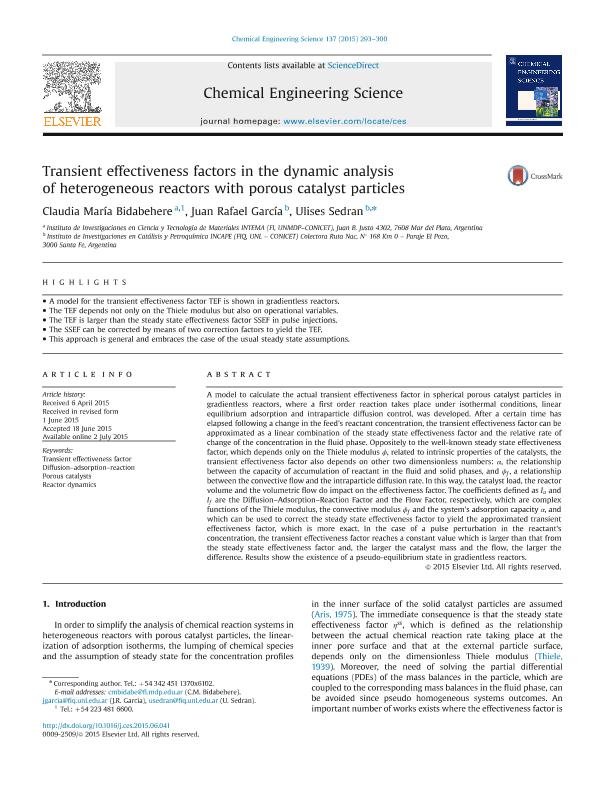Mostrar el registro sencillo del ítem
dc.contributor.author
Bidabehere, Claudia María

dc.contributor.author
García, Juan Rafael

dc.contributor.author
Sedran, Ulises Anselmo

dc.date.available
2018-01-30T15:46:13Z
dc.date.issued
2015-12
dc.identifier.citation
Bidabehere, Claudia María; García, Juan Rafael; Sedran, Ulises Anselmo; Transient effectiveness factors in the dynamic analysis of heterogeneous reactors with porous catalyst particles; Elsevier; Chemical Engineering Science; 137; 12-2015; 293-300
dc.identifier.issn
0009-2509
dc.identifier.uri
http://hdl.handle.net/11336/34986
dc.description.abstract
A model to calculate the actual transient effectiveness factor in spherical porous catalyst particles in gradientless reactors, where a first order reaction takes place under isothermal conditions, linear equilibrium adsorption and intraparticle diffusion control, was developed. After a certain time has elapsed following a change in the feed׳s reactant concentration, the transient effectiveness factor can be approximated as a linear combination of the steady state effectiveness factor and the relative rate of change of the concentration in the fluid phase. Oppositely to the well-known steady state effectiveness factor, which depends only on the Thiele modulus ϕ, related to intrinsic properties of the catalysts, the transient effectiveness factor also depends on other two dimensionless numbers: α, the relationship between the capacity of accumulation of reactant in the fluid and solid phases, and ϕf, a relationship between the convective flow and the intraparticle diffusion rate. In this way, the catalyst load, the reactor volume and the volumetric flow do impact on the effectiveness factor. The coefficients defined as Ia and If are the Diffusion–Adsorption–Reaction Factor and the Flow Factor, respectively, which are complex functions of the Thiele modulus, the convective modulus ϕf and the system׳s adsorption capacity α, and which can be used to correct the steady state effectiveness factor to yield the approximated transient effectiveness factor, which is more exact. In the case of a pulse perturbation in the reactant׳s concentration, the transient effectiveness factor reaches a constant value which is larger than that from the steady state effectiveness factor and, the larger the catalyst mass and the flow, the larger the difference. Results show the existence of a pseudo-equilibrium state in gradientless reactors.
dc.format
application/pdf
dc.language.iso
eng
dc.publisher
Elsevier

dc.rights
info:eu-repo/semantics/openAccess
dc.rights.uri
https://creativecommons.org/licenses/by-nc-sa/2.5/ar/
dc.subject
Transient Effectiveness Factor
dc.subject
Diffusion-Adsorption-Reaction
dc.subject
Porous Catalysts
dc.subject
Reactor Dynamics
dc.subject.classification
Otras Ingeniería Química

dc.subject.classification
Ingeniería Química

dc.subject.classification
INGENIERÍAS Y TECNOLOGÍAS

dc.title
Transient effectiveness factors in the dynamic analysis of heterogeneous reactors with porous catalyst particles
dc.type
info:eu-repo/semantics/article
dc.type
info:ar-repo/semantics/artículo
dc.type
info:eu-repo/semantics/publishedVersion
dc.date.updated
2018-01-18T14:39:59Z
dc.journal.volume
137
dc.journal.pagination
293-300
dc.journal.pais
Países Bajos

dc.journal.ciudad
Amsterdam
dc.description.fil
Fil: Bidabehere, Claudia María. Consejo Nacional de Investigaciones Científicas y Técnicas. Centro Científico Tecnológico Conicet - Mar del Plata. Instituto de Investigaciones en Ciencia y Tecnología de Materiales. Universidad Nacional de Mar del Plata. Facultad de Ingeniería. Instituto de Investigaciones en Ciencia y Tecnología de Materiales; Argentina
dc.description.fil
Fil: García, Juan Rafael. Consejo Nacional de Investigaciones Científicas y Técnicas. Centro Científico Tecnológico Conicet - Santa Fe. Instituto de Investigaciones en Catálisis y Petroquímica ; Argentina
dc.description.fil
Fil: Sedran, Ulises Anselmo. Consejo Nacional de Investigaciones Científicas y Técnicas. Centro Científico Tecnológico Conicet - Santa Fe. Instituto de Investigaciones en Catálisis y Petroquímica ; Argentina
dc.journal.title
Chemical Engineering Science

dc.relation.alternativeid
info:eu-repo/semantics/altIdentifier/doi/http://dx.doi.org/10.1016/j.ces.2015.06.041
dc.relation.alternativeid
info:eu-repo/semantics/altIdentifier/url/https://www.sciencedirect.com/science/article/pii/S0009250915004492?via%3Dihub
Archivos asociados
